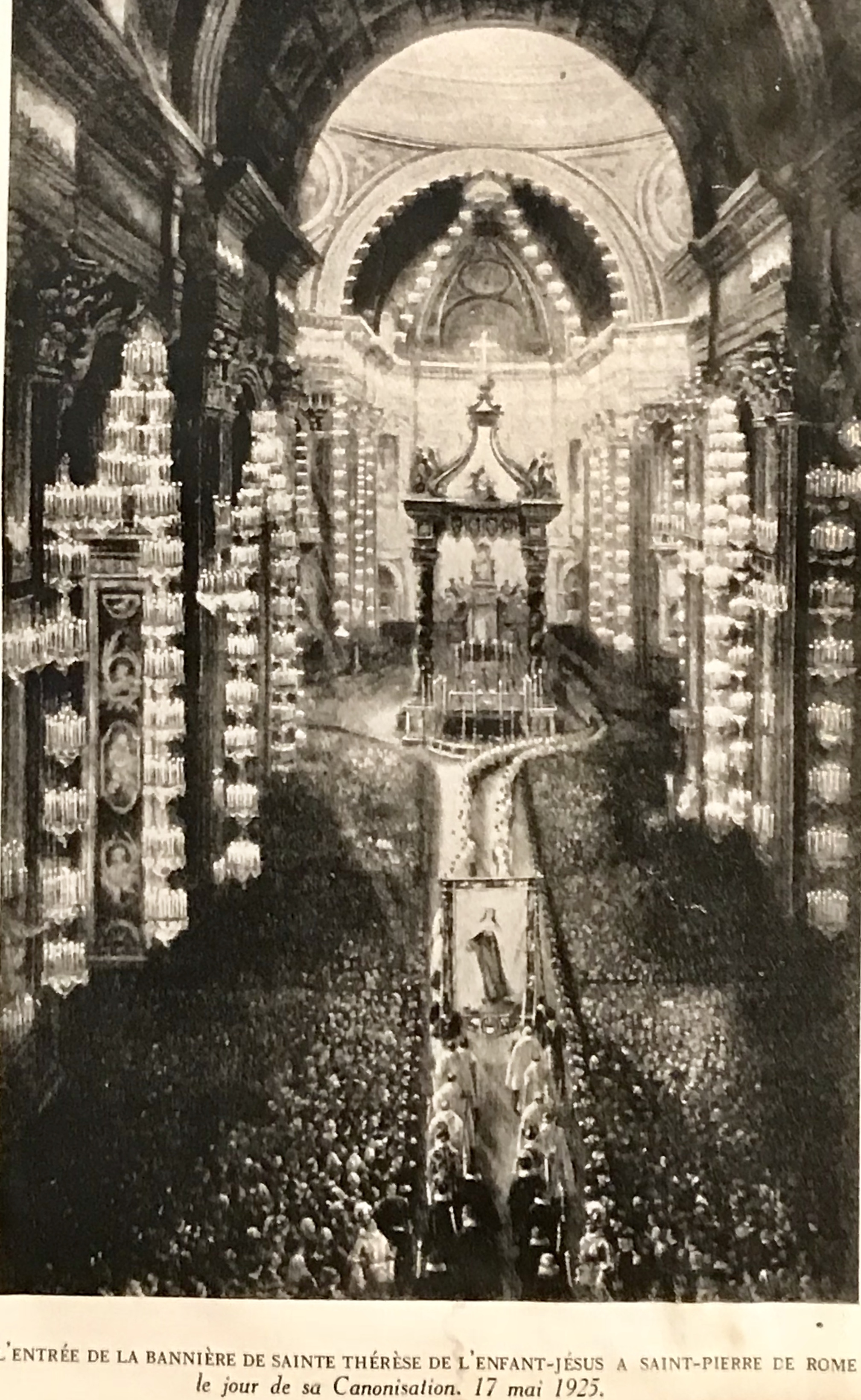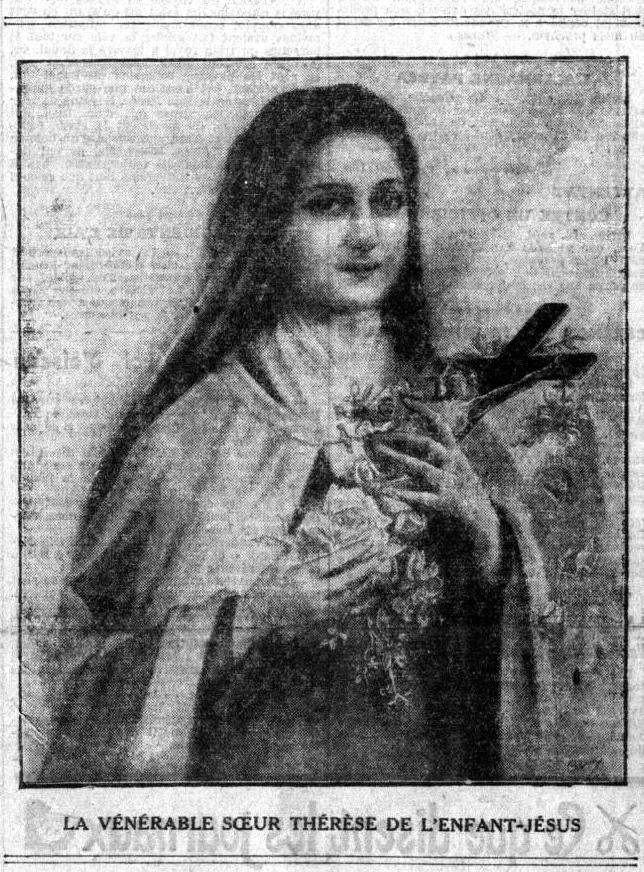Saint Therese of the Child Jesus
of the Holy Face
St. Therese canonized in Rome, May 17, 1925
 The banner of St. Therese is carried into St. Peter's Basilica in Rome at her canonization ceremony, May 17, 1925. Credit: Wikipedia, Exorcisio Te, https://commons.wikimedia.org/wiki/Category:CC-BY-SA-4.0
The banner of St. Therese is carried into St. Peter's Basilica in Rome at her canonization ceremony, May 17, 1925. Credit: Wikipedia, Exorcisio Te, https://commons.wikimedia.org/wiki/Category:CC-BY-SA-4.0
St. Therese’s Canonization Ceremony
St. Therese of the Child Jesus was canonized in Rome on May 17, 1925, 95 years ago today. The New York Times reported that at least 25,000 French and fully 15,000 American pilgrims were present for the six-hour ceremony. The basilica held almost 60,000 pilgrims, and 200,000 more waited in the square outside. For the first time, loudspeakers were installed in the Basilica, so that all the pilgrims crowded inside (many of whom could not see the sanctuary) were able to hear the Pope’s every word. This innovation was a big success.
Outer Facade of Basilica Illumined for the First Time Since 1870
Countless electric lights had been installed in the basilica for the ceremony. The newspapers reported extensively that that night, for the first time since 1870, the outer façade of St. Peter’s was illumined.
The illumination was done entirely with thousands of torches and lanterns, which, flickering in the breeze, gave the impression that the whole basilica was enveloped in a curtain of fire. It is estimated that this beautiful scene was witnessed by about a million people.
The New York Times, May 18, 1925, p. 2.
The illumination was considered a step toward the reconciliation of the church and the Italian state, for it was the first time the facade pf the Basilica had been lit up since the Pope became a voluntary “prisoner in the Vatican” after the Italian government declared war on the Papal States in 1870.
Recreate St. Therese's Canonization Ceremony for Yourself
Although the rest of this aritcle may look like a mere list of links, it is in fact, the key to a powerful interactive experience of the canonization. To respect the intellectual property of others, I can't reproduce everything on this page, but, merely by clicking the links, you can access a vivid sense of what the pilgrims experienced in 1925.
A Contemporary Eyewitness Account of St. Therese's Canonization
For a contemporary eyewitness account from Australia, which gives the reader the sense of being present, please read "Over 60,000 at St. Therese's Canonization. His Holiness Proclaims New Glory of Carmel. All Nations Represented at the Happy and Impressive Event" from the Freeman's Journal (Sydney, New South Wales, July 2, 1925).
Photographs of St. Therese's Canonization
See photographs of the celebrations at Lisieux and at Rome on the Web site of the Archives of the Carmel of Lisieux.
The Bull of Canonization for St. Therese
- To recreate the ceremony, read the Bull of Canonization. (Thanks to the Catholic Forum and the Internet Archive).
- Also see a beautiful illuminated parchment of the Bull of Canonization. It escaped the flames when Lisieux was bombed in 1944, but the parchment is twisted from the effects of the intense heat. (Thanks to the Web site of the Archves of the Carmel of Lisieux).
The Homily of Pope Pius XI at St. Therese's Canonization
See the text of the homily of Pope Pius XI. (Thanks to the Catholic Forum and the Internet Archive). That afternoon Pope Pius, who remained extraordinarily devoted to St.Therese until his death, told Dennis Cardinal Dougherty of Philadelphia that it was the happiest day of his life. After the tiring six-hour canonization ceremony, he returned to the Basilica later in the afternoon to venerate St. Therese. There many of the 200,000 pilgrims who could not gain admittance in the morning had the joy of praying with him.
A Detailed Account of St. Therese's Canonization Day by John Beevers
For a full account of the whole occasion, see this excerpt from John Beevers' book Storm of Glory: The Story of St.Therese of Lisieux. (Thanks to Hathitrust for digitizing the book). John Beevers was a British laywan who had a great love for St. Therese, translated her autobiography, and wrote two other books about her. I am greatly in his debt, for I believe that it's he who introduced me and many others to St. Therese.
On April 25, 1897, St. Therese wrote, contrasting her mission with that of St. Joan of Arc:
I understood my missionwas not to have a mortal King crowned but to make the King of heaven loved, to submit to Him the Kingdom of hearts.1
On this anniversary of St. Therese's canonization, when the whole world has such need of her way of confidence and love, let's canonize her afresh in our hearts. Above all, let's surrender our hearts to her Beloved so that we, too, can fulfill her only desire: "to love Jesus and to make Him loved."
Notes:
1. Letters of St. Therese of Lisieux, Volume II, 1890-1897. Tr. John Clarke, O.C.D. (Washington, D.C., Washington Province of Discalced Carmelites, Inc., p. 1085).
The 100th anniversary of the canonization of Joan of Arc on May 16, 1920
Icon of Joan of Arc by Brother Robert Lentz.
Available at Trinity Icon Stores
The canonization ceremony of St. Joan of Arc
Joan of Arc was Declared to have practiced heroic virtue, and thus given the title "Venerable," in 1894, in the lifetime of St. Therese, who called her "my dear sister." She was declared blessed in 1909. Her canonization took place at St. Peter's Basilica in Rome on May 16, 1920, fiveyears and one day before Therese's. Pope Benedict XV, who in 1921 would declare that St. Therese had practiced heroic virtue, presided at the ceremony. Estimates of the number of pilgrims in Rome range from 25,000 to 60,000. Newspapers report that many pilgrims had to sleep in the basilica and that many women fainted from the crush during the ceremony. (It is said, however, that the celebration for Therese far outshone that for Joan).
Photographs
Click on photographs of the canonization ceremony at the New Liturgical Movement Web site to see good photos.
Newspaper articles
- A good eyewitness account is at An Australian and St. Joan of Arc: Father Brauer of Manly College Describes the Canonization Ceremonies. (1920, September 30). Freeman's Journal (Sydney, NSW : 1850 - 1932), p. 7. Retrieved May 17, 2020, from http://nla.gov.au/nla.news-article115600407.
- On May 17, 1920, The Times of London offered a British analysis of the canonization and of Joan's sainthood in "St. Joan of Arc"
- If you read French, La Croix offers "Fete incomparable: La Canonization de Jeanne d'Arc," a marvelously detailed account on May 18, 1920.
Contemporary reflection on St. Joan and St. Therese
"St. Therese of Lisieux and St. Joan of Arc," by Maureen O'Riordan. I furnish some background on Therese's relationship with Joan, guide you to her texts about Joan, and present a few themes to empower your own reflection.
"St. Therese of Lisieux and St. Joan of Arc?" - an article about a lecture by Dr. Mary Frohlich, RSCJ, presented at the Washington Theological Union in 2007. Superb; excellent background about the role played by Joan in France during the lifetime of Therese and afterward. With thanks to the Internet Archive.
St. Therese and the Influenza Pandemic in the Lisieux Carmel, December 1891-January 1892 - Part I - Timeline
 St. Therese at 16, in January 1889
St. Therese at 16, in January 1889
A new documentary about St. Therese: "Secrets d'histoire - Therese, la petite sainte de Lisieux," broadcast by France 3 on May 4, 2020
I am delighted to be able to introduce you to this magnificent documentary ["Secrets of history - Therese, the little saint of Lisieux'], narrated by Stephane Bern for France 3. More than 2.45 million people, 10% of the population of France, watched its first broadcast in France last night. What a moment of evangelization! I thank France 3 for making the replay available on Youtube the same day, so that those outside France can enjoy it. Nearly two hours long, it goes by like a flash. With this film you can not only visit the places of Therese's life in Alencon, in Lisieux, on the pilgrimage to Rome, and at the Carmel but also delve deep into her life story and its significance. Long visits to the Lisieux Carmel blend with 19th-century photos to allow us to see the environment of Therese's everyday life in minute detail. The film is punctuated by a series of short interviews with many persons extremely knowledgeable about St. Therese's life and spirituality. Although they are, of course, in French, the visuals are so powerful that even those who do not speak French can't help but enjoy the film. I congratulate everyone who had a part in its production. What do you think of it?
"Beatification of the LIttle Flower As Seen By A South Australian," an eyewitness account of the day Sister Therese was named blessed, April 29, 1923

with thanks to the Southern Cross, published in Adelaide, South Australia from 1889 through 1954.
BEATIFICATION OF THE
LITTLE FLOWER. «AS SEEN BY A SOUTH AUSTRALIAN.
The following account of the recent beatification in Rome of Soeur Therese of Carmel (the Little Flower) (by a South Australian student in Rome is of special interest:—
To-day (the Feast of St. Catherine) I had the happiness of assisting at Mass and receiving Holy Communion in the crypt of St. Cecilia, which, in my opinion, is the loveliest shrine in all Rome.
One of our young Fathers went down there to say Mass this morning, and when we got there we found a French priest saying Mass for an old Frenchman and his three daughters.
The old man was serving Mass, and the sight reminded me of that other old Frenchman who came there with his two daughters 36 years ago and knelt where I was kneeling. What a glorious day it has been! To-day I was present at the crowning of our 'Little Queen." This morning I went to St. Peter's. The sky was overcast and rain seemed imminent. On entering the piazza one beheld a continuous stream of people flowing into the Basilica. Over the central door from the loggia from which the Pope gives his blessing was suspended a large banner, which, however, was veiled so that one oould not see what was on it. On entering the vestibule one beheld over the central door leading into the church itself a large picture of the Little Flower clothed in white, seated beside her father in an old garden.
In the background is seen the Carmel of Lisieux. She is asking her father's permission to enter. He holds one of her hands in his and is speaking the words which cost him so much, but the reward of which he is reaping to-day in the glory of his "Little Queen." Inside the Basilica there were thousands upon thousands of people, a great number of whom were pilgrims from every country under the sun. Upon two of the piers supporting the dome were pictures representing miracles wrought by the Little Flower—one that of the cure of a nun, the other that of the cure of a priest. I presume these were two of the miracles formally proposed to prove the sanctity of Theresa.
The apse was hung with damask, while the space occupied above the Pope's throne by the stained glass window of the Holy Ghost was covered by a curtain which hid from view the picture of the Little Flower destined to be exposed when the Bull had been read and the Papal decree raising her to the altars of the Church had been promulgated. Electric chandeliers—a perfect forest of them —were suspended from the ceiling.
At 10 o'clock the procession of cardinals came from the sacristy. (By this time the electric chandeliers had been switched on, producing an effect that can scarcely be imagined). Behind the cardinals walked the Bishop of Bayeux—the diocese in which Lisieux is situated—who was to celebrate the High Mass. Behind him walked Cardinal Merry del Val, Archpriest of St. Peter's.
When the procession had reached the charter in the apse the Bull was read from a pulpit erected for the purpose, and at the end the curtains veiling the picture of the "Little Queen" above the throne was removed, and in a sudden blaze of light she was seen in glory casting her roses upon the earth. The effect was wonderful, and as the choir burst forth into the Te Deum, which was taken up by the people, I noticed quite a number around me crying at that moment. One felt that the Little Flower was not far off.
What a change had taken place since she stood in St. Peter's, a child of 15, broken-hearted and downcast because Leo XIII did not speak the one word necessary to open the doors of Carmel. Then she was a child unknown, to-day her name was on the lips of millions throughout the world. The greatest temple on this earth was decorated in her honor, and thither had come people from every country under the sun at the invitation of Pope Pius XI., who himself was coming officially, as head of the Church on earth, to pray to her who had come a suppliant to the feet of his predecessor. Surely if ever to-day was realised the truth of that text of which Theresa was so fond—"Unless the grain of wheat falling into the ground die, itself remaineth alone. But if it die, it foringeth forth much fruit." How could any girl die more to the world than by entering a Carmelite monastery? Yet to-day there is no saint in the whole Church of God more popular—after Our Lady— than the little unknown Carmelite nun.
I went back to St. Peter's in the afternoon. The piazzo was crowded and a great number of troops were massed to keep order. I got a ticket for a place in the left transept, opposite the High Altar. The crush was fearful—not as bad as that of the coronation, however. The Pope was carried in ion the sedia gestatoria, but without the fans and tiara. He wore the white skull cap. Benediction was given in the apse. I couldn't see, as it was round the corner. The Pope was presented with the reliquary and also with the presents usual on such an occasion. Among them was a beautiful bouquet of roses (most appropriate for the occasion), which, I think, came from Ireland. I forgot to tell you that the picture in the piazza when unveiled in "the morning showed the Little Flower kneeling before Our Lady and receiving from the hands of the Infant in her arms roses which she, in turn, showered into the piazza of St Peter's. So ended tone of the great days of my life. You know the Little Flower told someone that when Rome would speak her shower of roses would become a torrent. Already I have had proof that she is keeping her word. I had from the moment I entered the Basilica that morning a firm conviction of it and I had not long to wait.
Citation: BEATIFICATION OF THE LITTLE FLOWER. (1923, August 3). Southern Cross (Adelaide, SA : 1889 - 1954), p. 17. Retrieved April 30, 2020, from http://nla.gov.au/nla.news-article167742193

